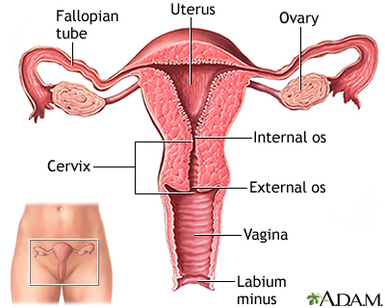When it comes to cervix health, we often hear the bad news: risk of cancer, the need for Pap smears, HPV and HPV vaccinations. Cervical cancer is a reality, with an estimated 528,000 cases of cervical cancer worldwide, and 266,000 deaths, which makes it the fourth most common cause of cancer death for women.
But when was the last time you heard helpful and positive information about the cervix? This post is about just that: what your cervix does for you, what makes it unhappy and gets you in trouble, and how you can keep it healthy.
What is your cervix?
Your cervix is actually the lower part of your uterus, which extends into your vagina. It is the in-between area that sperm must traverse to reach the woman’s egg in order to achieve pregnancy. The cervix also becomes immensely dilated during labor and delivery: it’s a rite of passage for any new life.
In clinical terms, the cervix has three major functions:
- It allows for passage of menstrual fluid (your periods)
- It protects our uterus and upper reproductive parts
- And it promotes fertility and may aid in sexual pleasure[1]
The cervix is gatekeeper to our fertility for several reasons.
First, it produces the cervical fluid, the life-giving, sperm-nourishing fluid that is a critical component for a pregnancy to happen. This fluid is secreted in tiny capsules called crypts located on the wall of the cervix. We only have about 100 of these fluid-secreting crypts[2] and keeping them healthy is critical to our future fertility.
Second, the cervix itself, being a channel that leads to the uterus, physically opens (while secreting fertile fluid or to let sperm in) and shuts (and protect a pregnancy). It controls what goes in and out of our wombs. No wonder the World Health Organization dubbed it a “biological valve” during the 1972 colloquium on cervical fluid and human reproduction[3].
The basic, little-known, little talked-about facts are: 1) Your cervix is very important if you are interested in fertility and 2) It’s important if you are interested in simply staying gynecologically healthy.
Cervical dysplasia
The first and only time I’ve seen my cervix was about six weeks postpartum after my second all-natural birth. I was in for my routine checkup with my midwife who casually asked me if I wanted to see it. I can’t remember if I actually said yes but anyhow she positioned a mirror between my legs and – yep, there was it was.
“Aw, look how pretty it is!” I remember her saying. Midwives.
What I noticed immediately is that it had a nicely closed hole. Yay. Lucky me, everything is back in place. Now let me get dressed, please.
I really was pleased that my body had bounced back after another vaginal birth because the first time around I did have a touch of cervical dysplasia that warranted repeat Pap smears.
Cervical dysplasia means there are early-stage abnormal changes in the cells lining the cervix. If left untreated, it can lead to cancer.
People generally know about the controversial, much-promoted vaccine for HPV , which is also linked to abnormal cervical cell growth and subsequent cancer.
What they may not know are the following notable preventable factors linked to developing cervical dysplasia include:
- Smoking or exposure to secondhand smoke
- A diet that low in vitamin A, beta-carotene and folate
- Using oral contraceptives for more than 5 years
Yes ma’am, birth control pills are linked to cervical cancer. That’s why we here at Natural Womanhood are about educating women about promoting healthy, natural feminine genius, which includes knowing alternatives to the Pill.
Cervical inflammation – your lady parts under fire
The cells in your cervix are constantly changing, taking cues from the information in your internal environment to form and grow new cells while doing away with the old.
An opportunity for making healthy new cervical cells, or angry inflamed ones, is always just around the corner.
As with other parts of your body with high cell turnover (like your skin, or your gut), your cervix responds to exposure to helpful nutrients or harmful anti-nutrients, or toxins. It will develop signs of irritation and inflammation if you make lifestyle choices that tank your immune system and put your body into fight mode.
Choices like the aforementioned smoking, risky sexual behavior, and even stress (yes, stress is a choice) can compromise our cervix’s ability to ward off infection[4].
 Detecting an irritated cervix is easy
Detecting an irritated cervix is easy
With prolonged irritation, your cervix will get angry and inflamed. If you chart your cycle, you can easily detect this dysfunction. You cervix will start secreting poorer quality mucus in response to the inflammation.
A Fertility Care Practitioner would term this sub-par mucus “sticky,” “tacky” and/or “gummy,” which are the standardized terms that help women identify cervical inflammation, hopefully before it becomes a bigger problem.
Sticky, tacky and/or gummy discharge from the cervix after ovulation has passed is a big hint that your cervix isn’t happy. You see, after ovulation, the cervix should be shut, closed for business, thank you—come again. Not much should be coming out of it.
This is the relatively easy physiology and symptomology lesson your friendly HPV vaccine campaigner never tells you about.
Maybe they don’t know…I don’t know…no going to go into an indignant rant like I did in my breast cancer post.
I just know that in my small Fertility Care practice the women I teach appreciate learning what their cervixes are trying to tell them.
Cervicitis, ectropion, eversion, erosion. All diagnoses of cervical inflammation—your body inflamed, all treatable with NaProTechnology.
Preventing “angry cervix”
The natural, non-invasive strategies for preventing cervical inflammation are the same as the strategies you’d use to prevent inflammation anywhere else in the body (I’m a huge fan of my old client’s book Meals that Heal Inflammation as science-based source of holistic healing).
If you choose, you can focus on putting good information into your cervical cells and live like you want your cervix (and the rest of your constantly changing body) to thrive. Making choices that include high intake of antioxidants like vitamin E, C and beta-carotene, as well as reducing exposure to carcinogens like cigarette smoke or viruses like sexually transmitted HPV, helps keep your cervix in good shape. You can never go wrong covering half your plate with dark green and orange veggies…
I also cannot emphasize enough the importance of learning how to monitor your cervical fluid. This is how your cervix talks to you – but you’ve got to be listening!
References
[1] http://articles.chicagotribune.com/2012-09-19/health/sc-health-0919-lady-parts-20120919_1_medical-research-anatomy-cervix
[2] Hilgers, T. Reproductive Anatomy & Physiology.
[3] Hilgers, T. Reproductive Anatomy & Physiology.







